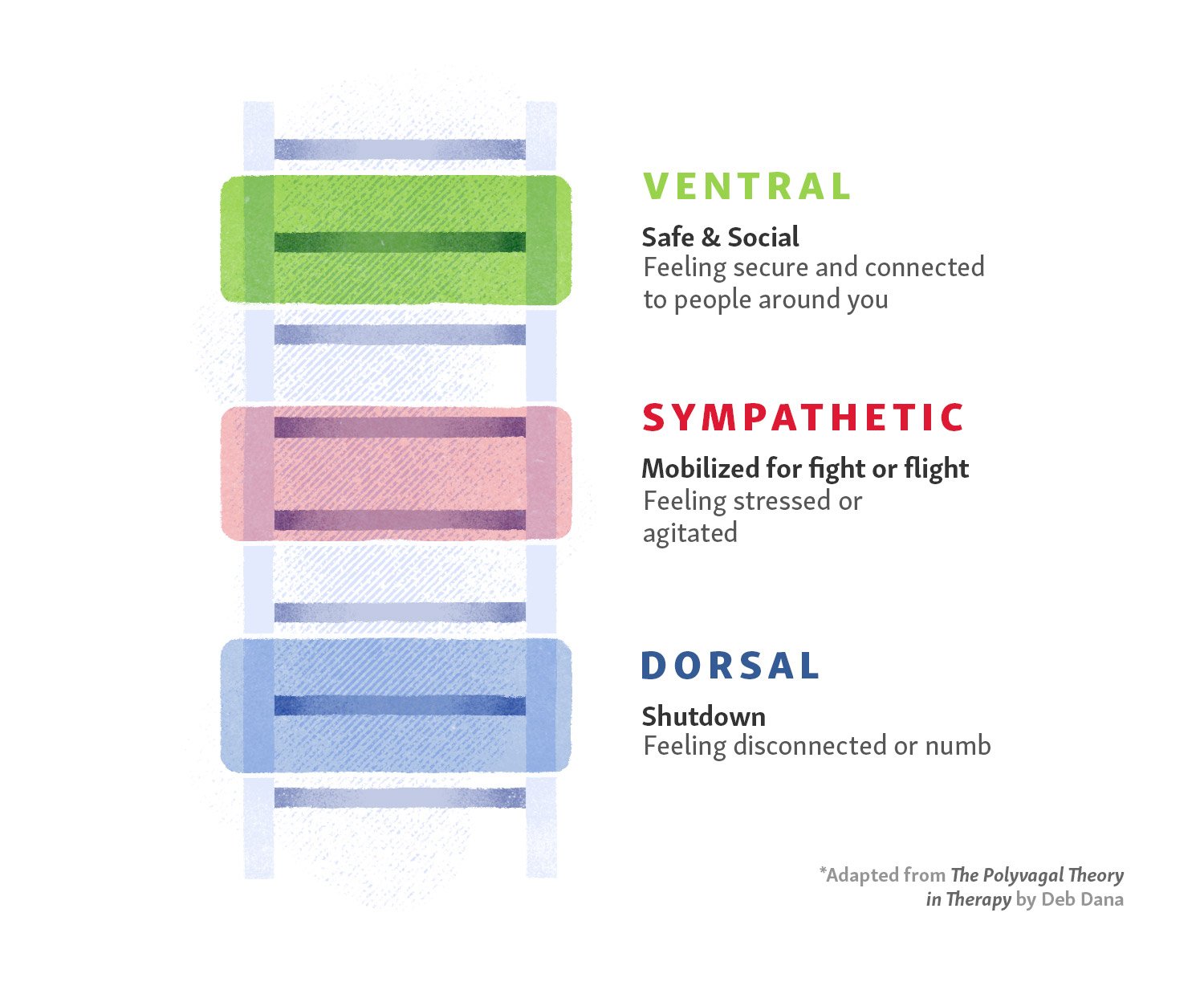Kat joined the Redeemer Team this summer, and we are so excited to have her on board! She is accepting new clients at our downtown office. If you are interested in scheduling, please call 407-405-7677 or email Kat directly to request more information.
By Kat Wilkins
(Information for this post paraphrased or quoted from The Polyvagal Theory in Therapy: Engaging the Rhythm of Regulation by Deb Dana). To download a PDF guide to the Personal Profile Map Exercise click here.
In this post, you'll learn a bit about Polyvagal Theory (the science of how we feel safe in relationships and environments), and learn how to "map" your own nervous system. The aim of this exercise is to provide new awareness of what your system is sensing around you, and how that impacts your ability to connect safely to yourself, your environment, and others around you.
What is Polyvagal Theory?
Polyvagal Theory was founded by Dr. Stephen Porges in the late 1960s. Deb Dana is largely responsible for bringing its application to the therapy context, and in her book The Polyvagal Theory in Therapy, Dana describes Polyvagal Theory (PVT) as "the science of safety": "the science of feeling safe enough to fall in love with life and take the risks of living. Polyvagal Theory provides a physiological and psychological understanding of how and why clients move through a continual cycle of mobilization, disconnection, and engagement." (emphasis mine). (p.xvii)
The Three Organizing Principles of Polyvagal Theory:
Hierarchy (aka the "ladder") - the autonomic nervous system responds to external/internal stimuli through three biological pathways, in a particular order, and is commonly demonstrated with a ladder image, as shown above. These three pathways are the dorsal vagus (immobilization), the sympathetic nervous system (mobilization), and the ventral vagus (social engagement and connection) (Dana, 4).
Neuroception (aka "magic antennae") - the term "neuroception" was coined by Stephen Porges, and refers to the ways our nervous system responds to safety cues and danger cues. It's like having magic antennae that are constantly scanning (6 times per second, actually) your "inside, outside, and between" (inside your body, the environment outside your body, and what's happening between you and other people). Different from perception, neuroception occurs deep underneath the conscious level of awareness. (Dana, 4).
Coregulation - This describes the process by which a nervous system is reciprocally regulated (brought back to "safety") in the presence of a safe "other" (caregiver, parent, etc). PVT sees co-regulation as an imperative in a person's ability to sustain life through being enabled to move into safe relationships and meaningful connections. (Dana, 4).
Personal Profile Map
Warning: Since this map includes specifics about your own nervous system states and responses, it is common for this to be a disruptive activity at times. I highly recommend doing this exercise with a trusted friend or therapist - but however you do it, please take some time to tune in to how you're doing. I strongly encourage you to take breaks as needed.
Now that we've covered the basics of Polyvagal Theory, let's consider an exercise of creating your own "personal profile map." When I do this with clients, I call it "mapping your nervous system."
It may be helpful to do some grounding for your system before you begin.
Let me invite you to take a deep breath in through your nose.
Hold that breath in for a few seconds.
Then, slowly exhale through your mouth.
Repeat as needed. (Feel free to skip any of this - you're in charge of your own body and how you move through this experience).
What we're attempting to do when we "regulate" or "ground" is to provide your system with as many safety cues as possible, as well as bringing your attention toward noticing those safety cues, and allowing your system to respond.
I invite you to take a few deep breaths before you begin. Take a moment to notice your breathing. Notice what the air feels like going in through your nostrils - notice the temperature.
Look around you in the space you're sitting in, and name out loud 5 items plus their color.
"The lamp is gold. There is a purple book next to me. The plant is green and brown. My shoes are gray. My chair is black."
When or if you're ready to move forward, let's begin.
Take a moment to draw a ladder like the one above, with 3 spaces. This is your nervous system map. As you move through the steps, feel free to be as creative as you want. You can write or draw with a pen or pencil, but I recommend that you use colored markers, as colors can evoke emotion and stimulate your system in a way that can add depth of meaning to the exercise.
As we cover each of the three spaces (in the order listed below), ask yourself these questions:
What emotions am I experiencing when I'm in this state? Eg. happy, ashamed.
What thoughts might I have when I'm in this state? Eg. "I'm bad," "I'm ok."
What might my body be doing in this state? Eg. curled up in my bed, open/closed posture.
When I'm in this state, how would I finish the sentence, "The world is _____?" (Eg. closing in on me, exciting, invisible)
When I'm in this state, how would I finish the sentence, "I am _____?" (Eg. unloveable, alone, not good enough, OK, stuck, free)
What physical landscape does this state feel like? (Eg. a cave, a sunny meadow, rapids)
What color does this state feel like?
What is my sleep/eating/substance use like when I'm in this state?
THREE NERVOUS SYSTEM STATES (start with middle, then bottom, then top):
Sympathetic nervous system: Start in the middle of your ladder. Recall a time when you felt mobilized, like there was too much energy pulsing through you. You might feel overwhelmed, scared, worried, anxious. Consider this experience only long enough to let your body taste it enough to begin mapping it.
Dorsal vagal: Now go to the bottom of your ladder. Recall a time you felt disconnected, or a sense of collapse. Your system doesn't have enough energy to function, and might be shutting down. You might feel hopeless, distant, unmotivated, or a lack of interest. "Dip your toe" into this feeling just a bit, and then begin to map it.
Ventral vagal: Now move to the top of your ladder. Remember a time you felt a warm feeling of well-being. Perhaps it was just a moment, or a prolonged experience. The world feels safe enough, you feel ok enough, and are generally safe to connect to yourself and others. Let this feeling fill you now, and begin to map it.
Once you've completed your map, take a step back and take it all in.
Notice in this moment, what state are you in? We ended our exercise with the ventral vagal state (top of the ladder) on purpose - but is your body still in that state?
Perhaps it isn't. Perhaps your system has moved you back into immobilization - you're feeling unmotivated and alone. Or, perhaps you're back in the middle of your map - you're feeling the stress of the day, and your body is pulsing with anxiety or tension. If so, perhaps you can begin to notice what "danger cues" (real or perceived) your system might be responding to.
Wherever you're at, my hope is that you've learned a bit about your own nervous system today in a way that increases curiosity and compassion. Perhaps you move throughout your day with more awareness of the present moment. Let this invite you to respond to your nervous system without judgment. When you're dysregulated (in the middle or bottom of your map), this means your system senses danger of some sort. Perhaps you can be curious about the story your particular nervous system might be telling you, and what it might need in order to safely connect and engage in your world.
Interested in learning more through therapy?
If you're considering therapy, feel free to reach out to me or any of the Redeemer counselors through the Redeemer website or by calling 407-405-7677. We would love to see if we might be a good fit for you and your therapy needs.
(Please note that this information is not a substitute for therapy. If this has disrupted you in any way, consider how you might find a safe person or therapist to process this with. Redeemer counselors are available and would be happy to hear from you if you'd like to explore therapy options).


